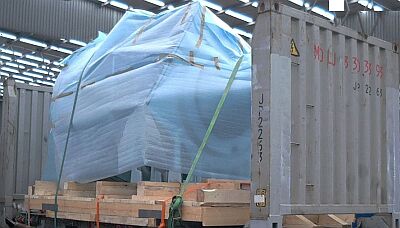 |
||
| Inadequately secured plant part on a 20' flatrack | ||
Such plant parts can only be adequately secured when they are so firmly bolted to the wooden bed that only the wooden bed itself needs to be secured. The weather protection fitted would be inadequate for carriage on a normal container ship, but this flatrack is intended for carriage below deck on a ro/ro ship.
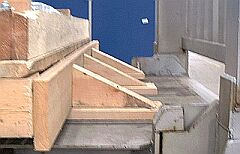 |
Inadequate lengthwise securing at one end |
Three nailed wedges are not up to preventing the plant part from moving in a lengthwise direction.
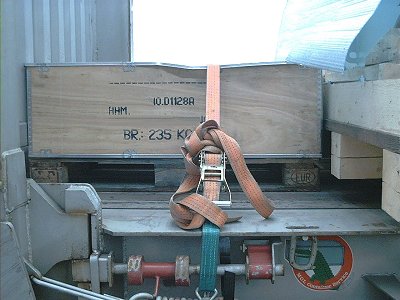 |
||
| Inadequate lengthwise securing at the other end | ||
It is more than optimistic to hope to prevent leftward movement of the heavy plant part with a relatively weak plywood case, and the lashing belt used to secure the plywood case (which has already deformed the case) deserves no further comment.
Wooden bracing covering the area of the bed to which the plant part is bolted would provide appropriate lengthwise securing. The appearance of such wooden bracing has already been sufficiently described. As the bed is overwidth, and the lengthwise members of the bed are completely covered with transverse planks, transverse securing using lashing means is not feasible or can only be achieved with corresponding additional effort.
Since the flatrack has stanchion pockets, the bed could be secured laterally using specially shaped stanchions, or appropriately sized case restraint shoes could be set in place before loading to achieve a tight fit between flatrack floor and plant part bed.
Leaving out two transverse planks at the bed ends would have made securing by loop lashings possible.
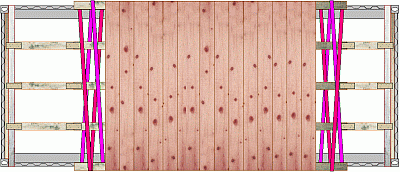 |
||
| Lengthwise securing using wooden bracing Transverse securing using loop lashings passed around the bed at the ends, around the lengthwise bed members |
||
Greater flexural strength could be achieved in the bed for securing purposes if the structure of the plant part allows planks to be omitted not absolutely at the ends but within the surface of the bed.
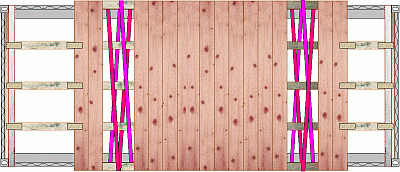 |
||
| Lengthwise securing using wooden bracing Transverse securing using loop lashings passed around the lengthwise bed members within the bed |
||
To achieve either variant, the lengthwise members of the bed must be firred to such a degree that the lashing means can be passed through without difficulty.
 |
||
| Firring of the lengthwise bed members, so that the lashing means can be passed through |
||
If the plant part itself had load-carrying fastening points, lateral securing could be achieved using direct lashings attached to them. However, care should be always be taken in the case of overwidth cargoes, as is the case here.
In this case, tie-down lashings, here constituting direct lashings, are suitable for vertical securing of the plant part.